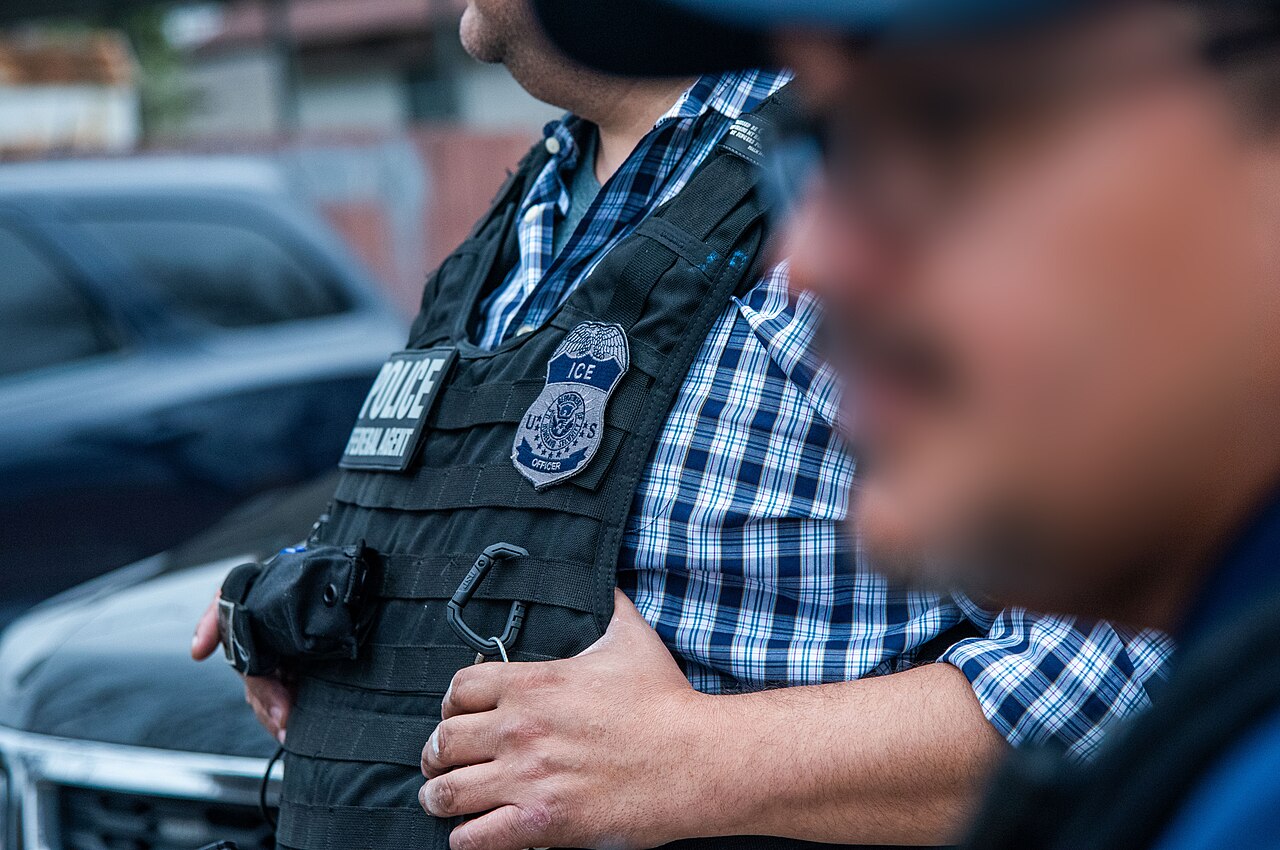Somewhere in Los Angeles, actor Ebbe Roe Smith was sitting in grueling traffic as was the norm, playing out a scenario in his head that many Angelenos have thought about at least once: leaving your car on the freeway and walking home. Smith channeled this frustrating part of L.A. life into the screenplay of one of the most polarizing films of the 1990s: Falling Down.
Directed by Joel Schumacher, Falling Down was released on February 26, 1993, and told the story of a recently laid off defense engineer who built missiles for the government, played by Michael Douglas.
On one particular day, growing agitated in the scorching Los Angeles heat, he leaves his car in traffic on the middle of a downtown freeway. The car’s license plate reads D-Fens, which becomes the character’s symbolic moniker throughout the screenplay. Over the course of the day, he treks across the city, completely on foot, to the Venice Beach house of his estranged ex-wife and daughter, on his daughter’s birthday.
Along the route, D-Fens, who sees himself as a victim, and something of a patriot, as he confronts characters who reflect the diverse though at times menacing cultural landscape of L.A. His deteriorating psyche, along with his antiquated and distorted worldview, lead to violent and sometimes deadly encounters.
Along with his personal experience, Smith also took into account an important real-life incident while writing Falling Down. On May 18, 1988, 25-year-old Charley Tom Lee Jr. turned his 18-wheel tractor-trailer into a driver’s worst nightmare. Lee rammed the vehicles of 21 motorists between the 10 Freeway near Temple City and the northbound Hollywood Freeway, where CHP officers were able to eventually pull over the truck and arrest Lee at gunpoint.
“It was like one minute you’re paying attention to the laws of the land and the next second they’re gone,” Smith said via phone from Portland, where I reached him to recall the process of selecting locations for Falling Down. “I just wondered about his process, his mind process. At what point did he just go, ‘Fuck it’?”
The Texas-based trucker had no explanation for his rampage, but according to an L.A. Times article that covered the sentencing, his family said that Lee was under immense pressure. His father had attempted suicide, his mother was dealing with a chronic illness, and he was worried that he couldn’t be a better provider for his wife and daughter. No one was seriously injured or killed in the incident, but Lee was sentenced to four years in California state prison for assault with a deadly weapon.
The highly publicized shooting of Latasha Harlins in 1991 wasn’t lost on Smith either. The 15-year-old African-American girl was accused of shoplifting a bottle of orange juice — a claim that was later refuted by witnesses and the police — and subsequently shot in the back of the head by Soon Ja Du, the Korean owner of a neighborhood market in South L.A.
Du was given probation and a fine in lieu of a prison sentence. Harlins’s death was just one of the tragedies simmering on the burner of the city’s consciousness at the start of the L.A. riots on April 29, 1992, which would actually impede production of Falling Down and other projects shooting in town.

Falling Down was the subject of controversy almost immediately upon its release. Through strident exchanges with a Korean grocery store owner, Latino gang members, a white supremacist in the form of a military surplus store owner, the Michael Douglas character as envisioned by Smith is an ambiguous figure who, depending on who is watching, could be taken as either victim or perpetrator.
“In the beginning you sort of sympathize with D-Fens. You think, look, I’ve felt frustrated on the highway. Wouldn’t it be wonderful if you could just leave your car,” said Falling Down co-producer, Dan Kolsrud, via phone from New York. “You can fantasize about those things, and little by little it just got worse and worse and you realize — ‘Wait a minute, I’ve been rooting for the wrong guy’.”
According to an analysis of the film by Jude Davies in the book series, Controversies, multiple organizations including the Korean American Coalition protested the film’s depiction and treatment of minorities, especially the grocery store owner, Mr. Lee (Michael Paul Chan). Additionally, the National Center for Career Change feared that the film would disgrace laid off defense workers because of the unhinged behavior of the film’s main character.
As recent as 2015, the film was cited in the case of Craig Stephen Hicks, who shot and killed his neighbors – three Muslim college students – in Chapel Hill, NC. Hick’s favorite movie, according to his ex-wife, was Falling Down.

The film’s production designer, Barbara Ling, said of the film during a recent interview, “I think it very much tried to keep a very fine line … of someone who has real emotional problems — mental problems — mixed with an extraordinary, odd view of what’s happened to America.”

For Smith, L.A.’s car culture was a driving force for setting the film in a city with a rapidly changing infrastructure in the 1990s. “One of the big aspects of it is that this guy gets out of his car and he’s walking, and you don’t do that in L.A. because you’re going through neighborhoods where you don’t belong,” said Smith. “It’s got all these neighborhoods, it’s got different demographics going on, and you’re crossing through them.”
“I was tempted at one point to try the walk, but I didn’t. I said, ‘Screw that,’” Smith said of D-Fens’s trek through L.A. “I think you could do the walk, you’d have to kind of book it, though, and not take little curves and go off in different directions.”
According to Google Maps, if you walked along the corridor of the 10 Freeway from downtown interchange where D-Fens left his car to the Venice pier where the film ends, the roughly 15-miles would take a little over five hours to accomplish without any stops.
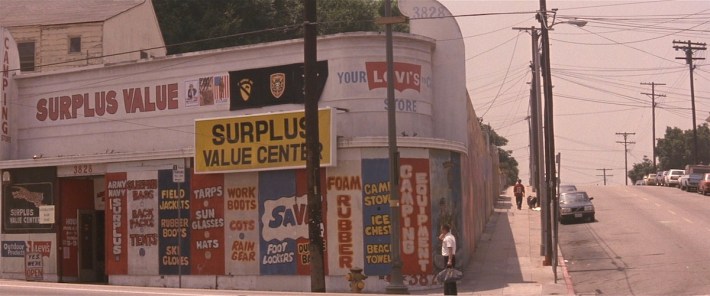

Though the film takes some detours in terms of its locations, resulting in what would have been a much longer walk for D-Fens, it was critical for Ling the keep the locations as geographically correct as possible. “We mapped this so that you really were going across [Los Angeles] from Silver Lake down to mid-city to Koreatown,” Ling said.
“Los Angeles is the story,” said assistant location manager Lisa Strout, who is currently director of the Massachusetts Film Office. “[Barbara] wanted us to find the story in actual places,” she added. “You felt like you were on this real journey.”

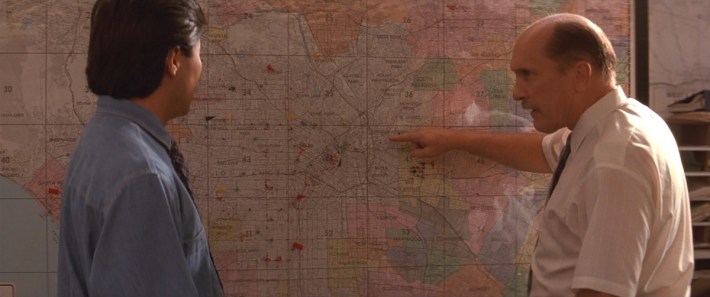
As an L.A. native who had lived all over the city from downtown to Santa Monica, Ling was able to enrich the film with a vivid sense of the city, making it a character of its own, and, as a result, helped create one of the definitive L.A. films. “I could give Joel a lot of [ideas about] if you were to trek across the city, visually, what would be an exciting and a very practical walk that would also give you this enormous change in life of where you are,” Ling said. “There are so many cool, little odd places that are on this route.”
For the 25th anniversary of Falling Down, which is Monday, Feb. 26, I made the trek to many of those places, and talked to some of the filmmakers about how a handful of them wound up in the film.

The Freeway
Upon typing into Google “Los Angeles freeway movie scenes,” most of the headlines that pop up on the first few pages are dedicated to how the filmmakers of La La Land (2016) closed a freeway ramp of the 110 and 105 interchange for the film’s sun-drenched opening musical number. Another few websites mention the white knuckled bus jump of Speed (1994), also shot along the 105 Freeway before it was completed and open to traffic. Eddie Murphy dodging speeding traffic along a busy L.A. freeway in Bowfinger (1999)? That was filmed along the Glendale freeway.
None of these (relatively speaking) less traveled, peripheral L.A. freeways, however, would suffice for the opening scene of Falling Down, which sees D-Fens playing out the fantasy that initially inspired Smith to write the film: getting out of his car and abandoning it in L.A. traffic.
Ling said, “[Caltrans and the city] originally offered things that were way out of the city that were just, like, one long freeway with nothing around it. We go, ‘No, no, no. We need to feel that we’re in the middle of Los Angeles.’”
To achieve the desired look the filmmakers’ were after, they proposed using a section of the southbound 110 Freeway as it intersected with the 101 Freeway in downtown L.A. The interchange – built in 1949, but not completely opened until 1953 – is sometimes referred to as the Four Level or the Stack. “You get a little bit of the mix master,” Ling said of the freeway location. “You get a little bit of a freeway over, a freeway in front, you feel like you’re in the middle of freeway claustrophobia.”

The stretch of freeway was also ideal from a production perspective, said Kolsrud, because it had a curve in part of the road, which enabled the filmmakers to hide production trucks from the camera’s view while also keeping equipment readily accessible.
“They actually keep freeways pretty busy in Los Angeles,” quipped Kolsrud. “I’m not sure that it could be done today. It probably took six or eight weeks to accomplish,” he said of the negotiations, which fell into his hands.
Caltrans wasn’t against letting the filmmakers use that section of freeway, according to Kolsrud, but they had their obvious concerns about closing down part of one of the busiest interchanges in the U.S. “I just said to them, ‘Well, why can’t we do that? What problem does it create? Maybe there’s a way we can solve the problem,’” said Kolsrud. After Caltrans posed every question or potential issue they could think of and Kolsrud provided a solution to each and every one, the filmmakers were granted permission to shoot on the freeway in downtown L.A.
The opening scene of Falling Down was shot over a period of two weekends as to lessen the impact on traffic. The Dodgers, playing about a mile away, had home games on one of the weekends, but twenty to thirty California Highway Patrol officers on motorcycles kept traffic to the stadium and around the interchange running smoothly. Rolling traffic breaks were implemented to bring in equipment, extras, and picture cars, of which there were dozens in order to create a real traffic jam. “Was it hard? It was really, really hard,” said Kolsrud. He added, however, “It worked seamlessly. It didn’t slow down traffic. Everything was great and we shot the way we wanted to shoot.”

The Market
Arguably the most controversial scene of Falling Down was a violent confrontation between D-Fens and the Korean grocery store owner, Mr. Lee. Without enough change to make a call on a pay phone, D-Fens walks into a nearby corner market and asks the proprietor to break a dollar bill. Mr. Lee tells D-Fens that he has to purchase something to get change. When D-Fens brings a can of Coke to the register and Mr. Lee informs him that the price is eighty-five cents – pronounced in an accent so it’s heard as “eighdy fie sen” – D-Fens ridicules Mr. Lee’s articulation, scoffs at the the price of the soda because it won’t leave him enough change for the phone call, and proceeds to vandalize Mr. Lee’s store in order to make a point that the prices are too high.
The combination of attributes for the market location was a tough find. It was imperative that it be located next to the freeway so as to associate it with the car that D-Fens just left behind. It would also play again later in the film when retiring robbery detective Prendergast (Robert Duvall) begins to make critical connections between D-Fens’s abandoned car and the assault on Mr. Lee. The setting also called for a billboard that was visible from the freeway as another piece of the puzzle that Prendergast was putting together.

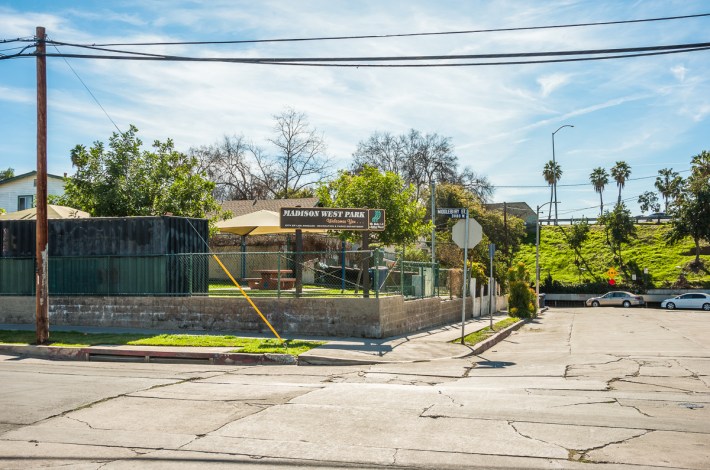
“I scouted for markets near a freeway for forever and a day,” said Falling Down assistant location manager Darrin Lipscomb. Lipscomb drove along the city’s freeways looking for the perfect configuration, but whether a store was painted the wrong color or there were other stores adjacent to the market, nothing panned out. He also scouted places that could double for a freeway.
Eventually, the corner of Middlebury Street and Madison Avenue, on the edge of Silver Lake next to the 101 Freeway, was chosen for Mr. Lee’s market.
The market exterior is long gone, and today a park stands in its place. However, the building itself was never there in the first place. “If that building was still there — where the park is — you’d open up the door and walk into a mound of dirt,” said Lipscomb. The filmmakers decided to build a façade of the market on the corner and combine it with the interior of Bob’s Market, the 103-year-old building on Kensington Road in Angelino Heights that later appeared as Toretto’s Market in The Fast and the Furious (2001).


Ling and her team took over Bob’s market for a period of a few weeks reconfiguring the interior and exterior. This included replacing the market’s garage door with windows and a proper door, which matched the façade on Madison Avenue.
The most visually striking element of the market location was the use of a warm amber lighting gel over the windows, resulting in a yellow glow throughout the store interior, which enforces the idea of sweat and suffocating heat that permeates the film. The gel not only provided the desired aesthetic, but it was also a practical decision, said Ling.
“They used to do these yellow or green shades [in the old days]. They were like a gel so that you could filter light coming in,” he said.


The Hillside
Opened in 2008, Vista Hermosa Natural Park in downtown boasts lush meadows, glistening streams, inviting picnic areas, and a remarkable view of downtown L.A. — only rivaled, perhaps, by the view from Dodger Stadium. Today, the location in no way resembles the dusty hillside where two gang members in Falling Down informed D-Fens that he was trespassing on their turf.
Like a number of the film’s locations, Ling was familiar with the spot and suggested it to Schumacher, who was unavailable for comment for this article.
According to the production designer, the most intriguing characteristics of the location were the ruins of houses, which were reminiscent of old Bunker Hill. “So you had all these old pieces of architecture – concrete architecture – that [were] still existing with grass growing around it.”
“Almost like you’re in Rome or something,” said Strout, laughing. “The antiquities of Los Angeles.”

The filmmakers made use of the idea of existing ruins, but Ling built the graffiti laced concrete foundation that D-Fens sat on as the gang members approached him. “There were pieces of things like that farther away, but they were not the right angle,” said Ling. “We had to fudge our own steps because, you know, it’s all about light. If you were starting to lose light you had to be able to quickly move the steps over to here,” added Ling.
The location and the set piece became part of the film’s iconic poster, which sees D-Fens standing atop of the foundation with briefcase in one hand, a shotgun in the other, a smog-covered downtown in the background.

The Drive-By Shooting
The first of just a few locations that strayed from D-Fens’s accurate east-west path moved the production over to Cesar E. Chavez Avenue just east of Soto Street in Boyle Heights. In the scene, D-Fens stands outside a row of neighborhood stores built into the front of an old theater. There, he makes another call to his ex-wife from a pay phone. At the same time, the gang members that D-Fens chased off on the hillside are seeking retribution, scanning the streets for any sign of him. Upon finding D-Fens, the gang members pull off a drive-by shooting, completely missing D-Fens, but riddling storefronts and other pedestrians with bullets.

The building where D-Fens made his phone call opened in 1926 as the Lido Theatre. It later changed to the Brooklyn Theatre, named for the original street prior to rechristening as Cesar E. Chavez Avenue in 1994. At the time of shooting Falling Down, the location was a swap meet, the old marquee reading “La Barata.”
Not only did the corner of Chavez Avenue and Fickett Street provide a strong sense of the neighborhood through which D-Fens was traveling, but also the T-intersection of these streets provided the camera the ability to look out the windshield of the drive-by car and see D-Fens straight ahead.
“You’re trying to figure out a great angle to show all of this in one piece before you actually start the shootout,” Ling said of the location.



Whammyburger
There used to a be a time — not too long ago, in fact — when you had to order breakfast in a fast food establishment by 10:30 am or so before the menu switched to lunch. Today, with the proliferation of “all-day breakfast” menus, there’s no need worry about the manager telling you you’re too late, which is exactly what happens when D-Fens walks into Whammyburger. The scene is one of the most memorable and perhaps most relatable in the film simply because D-Fens misses ordering off the breakfast menu by only three minutes.
Whammyburger turned out to be one of the most challenging spots to find for the film. Not only would the filmmakers have to take over a location for a period of time to redress it, but also it was highly unlikely that a franchise or chain fast food restaurant would be willing to associate itself with the content of the scene in question, or the film as a whole.
Armed with only a Thomas Guide, Lipscomb scoured almost the entire city of Los Angeles looking for the right location for a period of three weeks. “I just took a grid and I went all the way [to the] north San Fernando Valley, all the way down into South Central, just driving everyday,” said Lipscomb.
“You wanted to find a building that had some oomph to it that wasn’t just a little hamburger stand,” said Ling.


Upon scouting one possible restaurant with the crew, it was determined that the distance between the counter and the back wall was not deep enough for the required camera angles. “It missed it by inches,” said Lipscomb.
Eventually, Lipscomb ended up at a restaurant on Atlantic Avenue in the city of Lynwood in South L.A.: Angelo’s Burgers, which has been operating since 1978, would become the setting for the fictitious burger place.
The pavilion-shaped building, Ling said, provided a sense of structure and familiarity so that Whammyburger could easily have been McDonald’s.
The art department completely revamped the interior and exterior of Angelo’s Burgers, turning it into the working Whammyburger. Everything from a cheeseburger mural in the parking lot to the Whammyburger signage to the cardboard serving containers was created. “We, unfortunately, had to keep telling the neighborhood, ‘No, it’s not for real,’” Ling said, laughing.
While preparing the Whammyburger for filming the next day, the Rodney King verdict came down.
Without a cell phone in everyone’s pocket it was unbeknownst to Ling and her crew that the riots had started. “It’s, like, 5 o’clock. All of the sudden two Teamsters drive up in trucks and say, ‘The four of you, get in the trucks now,’” Ling recalled. “The art department coordinator couldn’t reach any of us [so] they finally went to the studio and said, ‘You gotta send Teamsters or something to go get them.’” When Ling and her crew rushed out of the Whammyburger, there was concern that the location might not be standing when the filmmakers returned, whenever that would be.

Filming throughout Los Angeles was completely shut down. “I think it was about a week that [the Whammyburger] sat dressed,” said Lipscomb.
During the unrest, Falling Down went to its cover sets at Warner Bros., said Ling, which included a detectives’ bullpen modeled after the actual Rampart division station and the military surplus store’s backroom.
Looking back, it’s not surprising to learn that not an inch of the Whammyburger had been affected. Like many business owners, the proprietor of Angelo’s Burgers protected his property during the riots. “I can remember clearly, the owner or manager … spent the night in that building with a shotgun to protect his place,” said Kolsrud.
The Whammyburger was the first location the production shot when it went back out on the streets. According to a plaque on the wall of Angelo’s Burgers, filming for Falling Down took place there on May 12, 1992, just under two weeks after the start of the riots.


The 110 & 105 Freeway Interchange
The reality of a constantly evolving Los Angeles, a theme at odds with D-Fens’s point-of-view, is an underlying motif reflected in the locations of Falling Down.
“L.A., especially in the ‘90s, you couldn’t believe construction. It was non-stop,” Ling said.
The filmmakers specifically incorporated the construction of the Metro Red Line station in MacArthur Park for a scene in which D-Fens has a confrontation with a homeless man who demands that D-Fens give him some money. The opening freeway scene includes dizzying jump cuts of flashing arrow panels and other construction signs as D-Fens sits in traffic.
This all comes to a head when D-Fens finds himself in the middle of a cacophony of blaring car horns and screaming drivers on a South Central street, adjacent to the interchange of the 110 and 105 Freeways. The traffic jam of apocalyptic proportions seems to be caused by roadwork leading up to the freeway interchange, but it doesn’t appear that any of the construction workers are actually doing anything.


This was also something of which Smith drew from his personal experience driving around L.A. “Everywhere you go there’s construction,” he remembered thinking, “and, you know, I’m going, ‘They’re not working, There’s nobody doing anything here. This is bullshit.’”
This time on foot, D-Fens approaches a construction worker, demanding to know what’s wrong with the street. When he learns that there’s actually nothing wrong with the street he produces a rocket launcher – taken from Nick (Frederic Forrest), the white supremacist surplus store-owner – and proceeds to blow up a crane.

All of this is set up against the backdrop of the brand new freeway interchange of the 110 and 105, the latter of which officially opened in October of 1993 after decades of planning and displacement. “To me, that area was showing how rapidly fast [the] infrastructure in this area is going to change,” Ling said.
It was a location that Ling said she wanted badly, but was very difficult to get. “It was just empty with stuff, you know, pipes and things,” Ling said, laughing. “[Caltrans was] so suspicious of what we wanted to shoot there and why [we] thought it even looked good, but it did look good. It’s an interesting part looking back at the freeway, and the tear away of how a neighborhood now is about to have these big buildings.”

Venice Beach
The decision to send D-Fens on a trek through L.A. that concluded on the Venice pier, where D-Fens was sent to his demise in the ocean below, was not Smith’s first instinct. In the original version of his screenplay, the film ended inside D-Fens’s estranged home, located in Venice and occupied by his ex-wife, Beth (Barbara Hershey), and their daughter.
“Locations had to really search out a place that had charm and felt like home,” said Ling of the desired characteristics of Beth’s house. “[D-Fens] wasn’t wealthy so it wasn’t to be something big, but you had to also make something that was big enough you could actually shoot some of the interior.”
Today, a single-family, deconstructivist home built in 1998 stands on the spot that was chosen for Beth’s house. Shaded by lush Monterey Cypress trees on Ozone Avenue two hundred feet away from the beach in Venice, the concrete house is a far cry from the modest bungalow that existed on this property in 1992 when it was used in Falling Down.




Another significant deviation was that D-Fens lived in the original script instead of being shot Prendergast.
“It was one of those things where [the producers] said, ‘This guy’s gotta die. You know, he’s gotta be punished for what he does,’” Smith recalled. Ultimately, it was a decision with which he agreed and the film’s ending was re-written to conclude on the Venice pier. “I like the [story] ending at the ocean. He went as far as he could go,” added Smith.
“There’s just something poetic about that in a sad way, though, that he just ends up in the water,” said Strout.
“That sense of water and salvation – you feel like that, for him, [it’s], ‘I’m home when I can start to smell the breeze,’” said Ling.
The pier also delivered a grander cinematic climax, in stark contrast to the film’s opening. “We start this movie so claustrophobic within the car,” said Ling. “To end inside of a house doesn’t feel like there’s any sense of redemption. It opened the film up at the end rather than put it back into the cave.”
However, at the time of filming Falling Down, the Venice pier had been closed since 1986 after pieces of concrete fell off the structure, almost injuring beachgoers, and a 120-foot-section was discovered to be slipping from the pilings. The pier had been slated for demolition, but after strong community protest, it was instead restored.

Strout recalled working heavily with City Council to obtain permission to film on the closed pier.
Lipscomb credits the efforts of Falling Down location manager, Antoinette Levine, who was not reachable for comment. “That took some work,” remembered Lipscomb of the pier negotiations.
“They had fixed it, but they hadn’t opened it yet, which was fabulous for our case,” recalled Ling.
“It helped because if it was open to the public, how would you keep them out,” wondered Strout. “It would be very difficult and people would be upset, like, ‘I came down here to walk down there and I can’t go there.’”
“It was serendipitous,” Ling said.
The Venice pier eventually reopened in 1997 after a $4.5 million restoration.
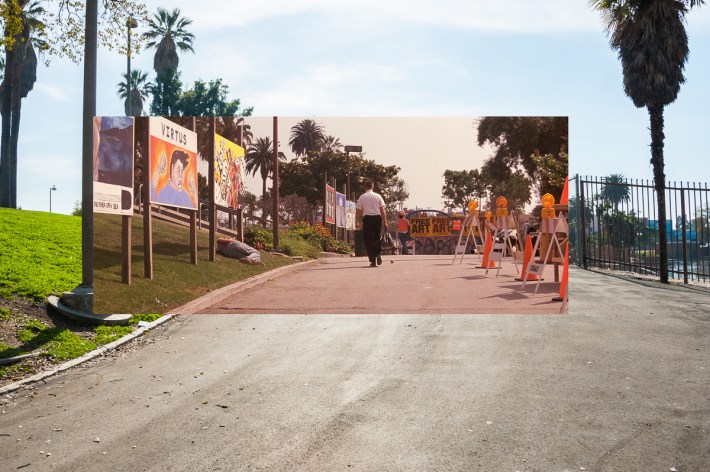
Please keep in mind that some of the locations are on private property. Do not trespass or disturb the owners. * Original photos by Jared Cowan.
RELATED: How Quentin Tarantino and 'Jackie Brown' Made the South Bay a Star.


